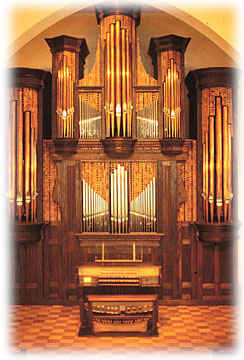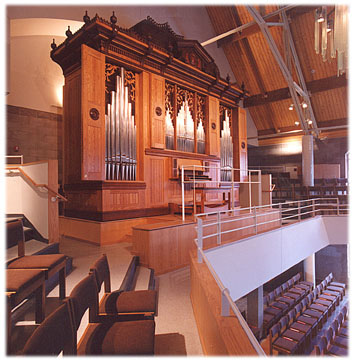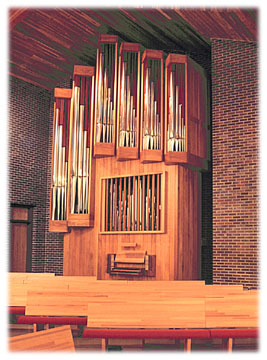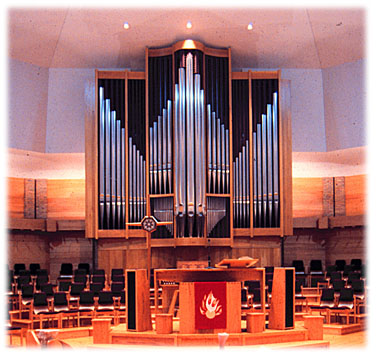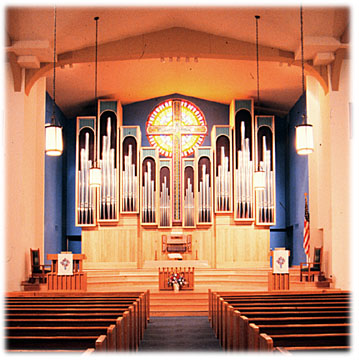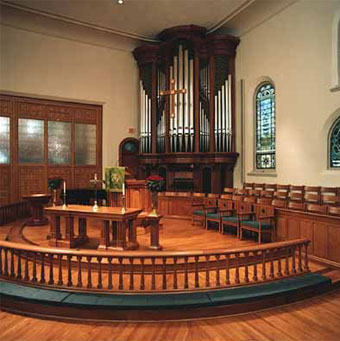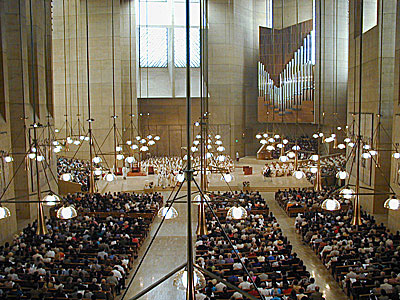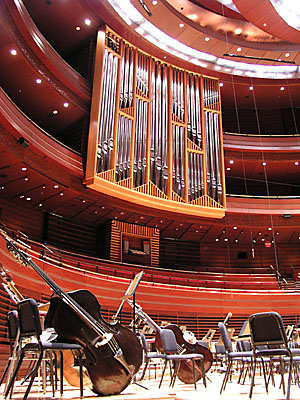 |
|||
 |
The young company’s first contract came from one of Dobson’s former teachers, Antony Garlick, a music professor and composer at Wayne State College. When Garlick moved in 1986, he sold the organ to Mary Brooks of Doylestown, Pennsylvania. In 1998 she in turn sold it to The Church of the Holy Spirit in Harleysville, Pennsylvania. Dobson was once again called upon to move the organ, and made several additions to suit its new, larger home.
Olivet Congregational Church - Op. 4 Dobson’s next project came from St. Paul, Minnesota, a forerunner of the many organs that would eventually be built for Twin Cities area churches and universities. Olivet Congregational Church commissioned a 24 stop organ, which presented a great challenge and opportunity for the small firm.
Bethany Lutheran College - Op. 10 As the 1970s closed, Dobson received commissions from two Minnesota colleges in addition to his work for churches. The first, a 7 stop practice organ for St. Olaf College, would be joined in 1985 by its more famous sibling, a 33 stop organ in Studio A, the firm’s first three-manual instrument. The second Minnesota institution, Bethany College, placed a 19 stop instrument in their chapel, located in the school’s historic Old Main. This instrument now resides in Bethany’s new Chapel, having been enlarged by Dobson for its new home.
Lake City Union Church - Op. 13 The 1980s opened with larger and more diverse projects. The Dobson firm was engaged by Westminster Presbyterian Church of Des Moines, Iowa, to complete the organ left unfinished by Lawrence Phelps Associates at the time of that firm’s bankruptcy. The Lake City Union Church, Lynn Dobson’s home congregation, purchased a two manual instrument.
St. Michael’s Church - Op. 23 The completion of large two manual organs for St. Michael’s Church in Stillwater, Minnesota and First Presbyterian Church in Manhattan, Kansas, set the stage for Dobson’s expansion into the rest of the country. In 1985, the company built an organ for The Church of the Holy Comforter in Burlington, North Carolina, its first instrument outside of the Midwest. Before the ’80s closed, Dobson would install instruments in Pennsylvania, New York and Virginia in addition to Midwestern locales.
Calvin College - Op. 44 Given the Dobson firm’s emphasis on instruments which support vibrant church music programs, it is no surprise that the company has received a large number of commissions from religious institutions. The instruments for Bethany Lutheran College and St. Olaf College have been noted above; as the firm entered the 1990s, it constructed instruments for Calvin College in Grand Rapids, Michigan, Augsburg College in Minneapolis, Minnesota and Wartburg Theological Seminary in Dubuque, Iowa; the first is a school of the Christian Reformed Church, the latter two are affiliated with the Evangelical Lutheran Church in America.
St. Luke’s Episcopal Church - Op. 57 The evolution of the firm’s tonal style was gradual. Although there have been examples of specialized instruments such as the organ in Italian style for Indiana University, most have an eclectic design. While the firm’s earlier instruments explored the neo-Classic aesthetic, work from this time became more complex, blending both Classical and Romantic influences in a way that would be familiar to musicians of the early 19th century. A significant step on this path was the construction in 1992 of a large two manual organ for St. Luke’s Episcopal Church in Kalamazoo, Michigan. Its eclectic tonal design, while providing more than a nod in the direction of 19th century English music, allows it to perform a wide variety of literature with fidelity.
First Methodist Church - Op. 60 The 1990s showed that Dobson was a firm with a national reputation, sending instruments to both ends of the continent. First Methodist Church in Mesa, Arizona, commissioned a three-manual mechanical-action organ that incorporated a Solo on 6" wind pressure as its third division. In New England, Dobson installed an organ at Pakachoag Church (UCC) in Auburn, Massachusetts, which is housed in a sumptuous cherrywood case inspired by the work of Father Smith. Though not a new instrument, the renovation and completion of the well-known Schlicker organ at Valparaiso University attracted favorable notice for Dobson’s enlargement of the organ’s capabilities while honoring its original character.
St. Paul’s Episcopal Church - Op. 70 Though not in unexplored territory for the firm, the 1998 organ at St. Paul’s Episcopal Church in Minneapolis unabashedly combines Classical and Romantic elements in a fresh and original way. This same line is followed in the instrument for West Market Street United Methodist Church in Greensboro, North Carolina, voiced in collaboration with Manuel Rosales. A somewhat more classical course was taken with the instrument at St. Joseph Abbey in St. Benedict, Louisiana, which is greatly enhanced by the five seconds of reverberation in the Abbey Church.
West Market Street Methodist Church - Op. 71 The opening of the new millennium was marked by the construction of Dobson’s largest organ to date, the 106 rank organ for Los Angeles’ new Cathedral of our Lady of the Angels. The new Cathedral, designed by Spanish architect José Rafael Moneo, encloses a volume of over three million cubic feet. The new organ is heroic, both tonally and visually.
Cathedral of Our Lady of the Angels - Op. 75 Following close on its heels and surpassing it in size was the Fred J. Cooper Memorial Organ, built for Verizon Hall in Philadelphia’s new Kimmel Center for the Performing Arts. The new organ features both an attached, mechanical action console, and a movable stage console that plays the organ electrically. With 125 ranks and 6,938 pipes, Op. 76 is the largest mechanical action organ in a concert hall in North America.
Verizon Hall - Op. 76 These landmark organs were by no means the only instruments coming from Dobson’s Lake City shop during this period. Instruments for worship settings remain the company’s principal focus. Two pipe organs in Pennsylvania display the range of this activity. The Lutheran Church of the Good Shepherd in Lancaster is home to an instrument that supports vigorous Lutheran liturgy and song, and whose contemporary visual design complements the strongly horizontal reality of its location.
Lutheran Church of the Good Shepherd - Op. 83 St. David’s Episcopal Church in Wayne, though a new building, has a more refined sensibility inspired by the architecture of the parish’s historic 1715 Church and the strong choral program. The organ is inspired by 19th century instruments, and boasts an enclosed Choir as its third division.
St. David’s Episcopal Church - Op. 84 • • • Each Dobson organ is as unique as its purchaser, yet a common thread of excellence runs through every instrument. Case design, tonal design, mechanical design, all may vary, but the same attention to detail is paid to the smallest item. |
||
|
Our Shop • Instruments • Recordings • Testimonials Dobson Pipe Organ Builders, Ltd. Site conception by metaglyph All contents ©1999–2016 Dobson Pipe Organ Builders, Ltd. |
|||


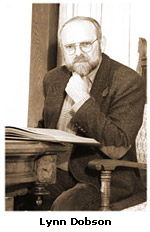 Lynn Dobson, the founder of the Dobson Pipe Organ Builders, was born in Carroll, Iowa, in 1949. He attended school in nearby Glidden, Iowa; in 1966, he attended the Minneapolis School of Art summer session for gifted students on a Hill Foundation Scholarship. He attended Wayne State College in Wayne, Nebraska, graduating in 1971 with majors in Art and Industrial Education. During his college years, he built a twelve stop mechanical action organ in a shed on the family farm; this organ was eventually sold to Our Savior’s Lutheran Church in Sioux City, Iowa, where it still serves today. Upon graduation, Dobson taught high school art in Plattsmouth, Nebraska. However, the desire to be involved with organbuilding persisted, and 1974 he worked briefly for the Hendrickson Organ Company of St. Peter, Minnesota. In November, 1974, Lynn Dobson established his own firm in Lake City, Iowa.
Lynn Dobson, the founder of the Dobson Pipe Organ Builders, was born in Carroll, Iowa, in 1949. He attended school in nearby Glidden, Iowa; in 1966, he attended the Minneapolis School of Art summer session for gifted students on a Hill Foundation Scholarship. He attended Wayne State College in Wayne, Nebraska, graduating in 1971 with majors in Art and Industrial Education. During his college years, he built a twelve stop mechanical action organ in a shed on the family farm; this organ was eventually sold to Our Savior’s Lutheran Church in Sioux City, Iowa, where it still serves today. Upon graduation, Dobson taught high school art in Plattsmouth, Nebraska. However, the desire to be involved with organbuilding persisted, and 1974 he worked briefly for the Hendrickson Organ Company of St. Peter, Minnesota. In November, 1974, Lynn Dobson established his own firm in Lake City, Iowa.